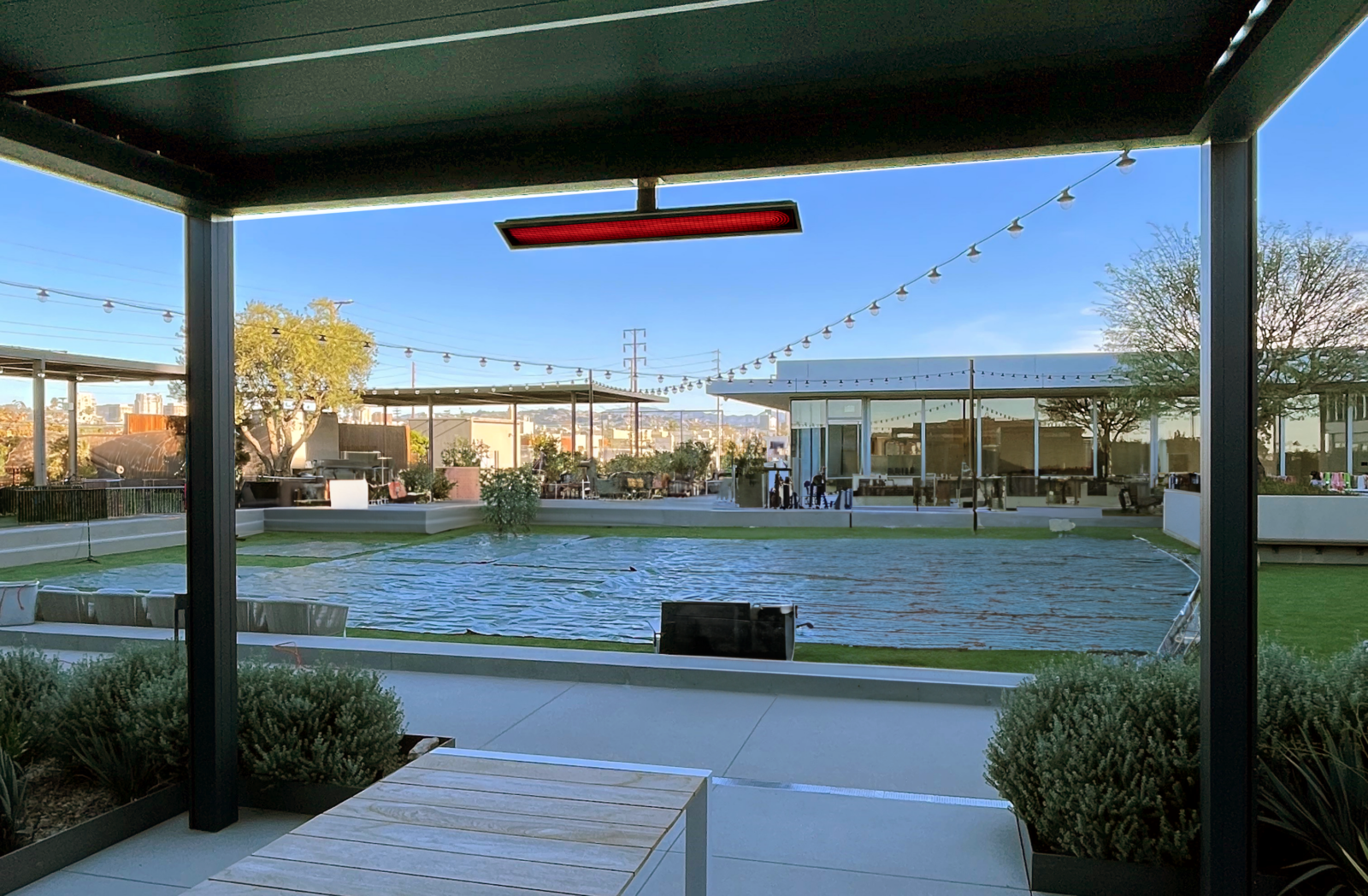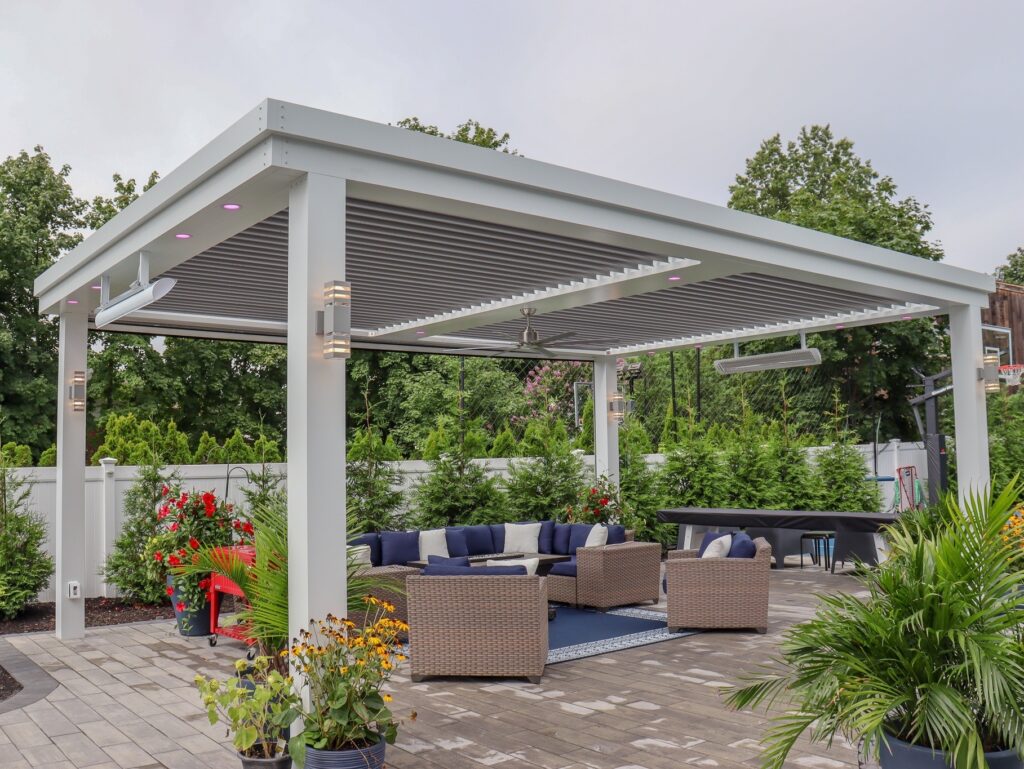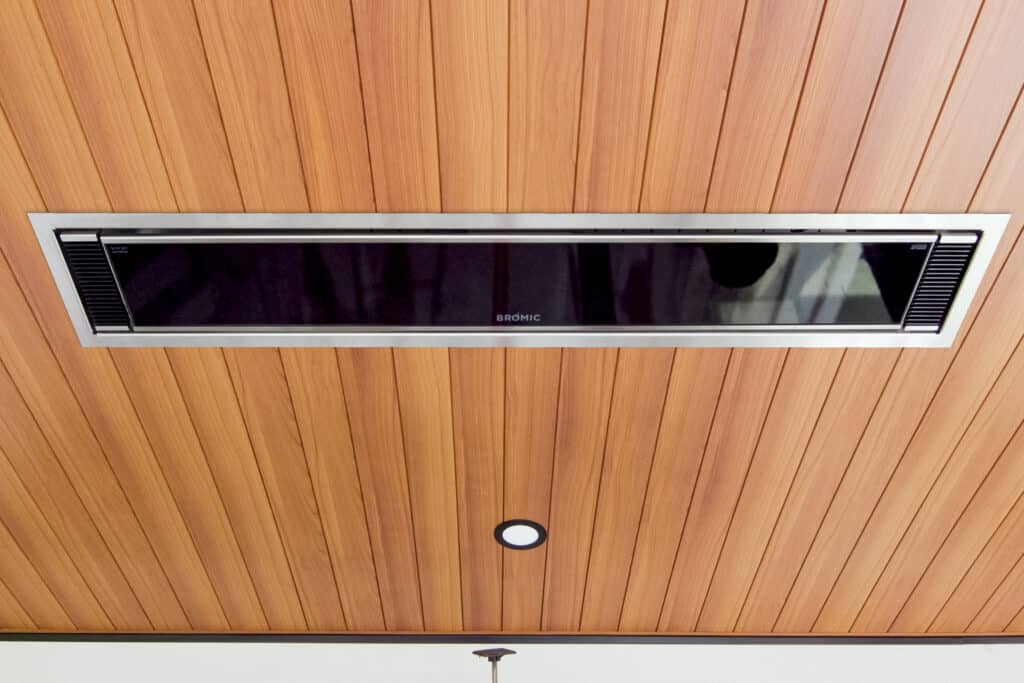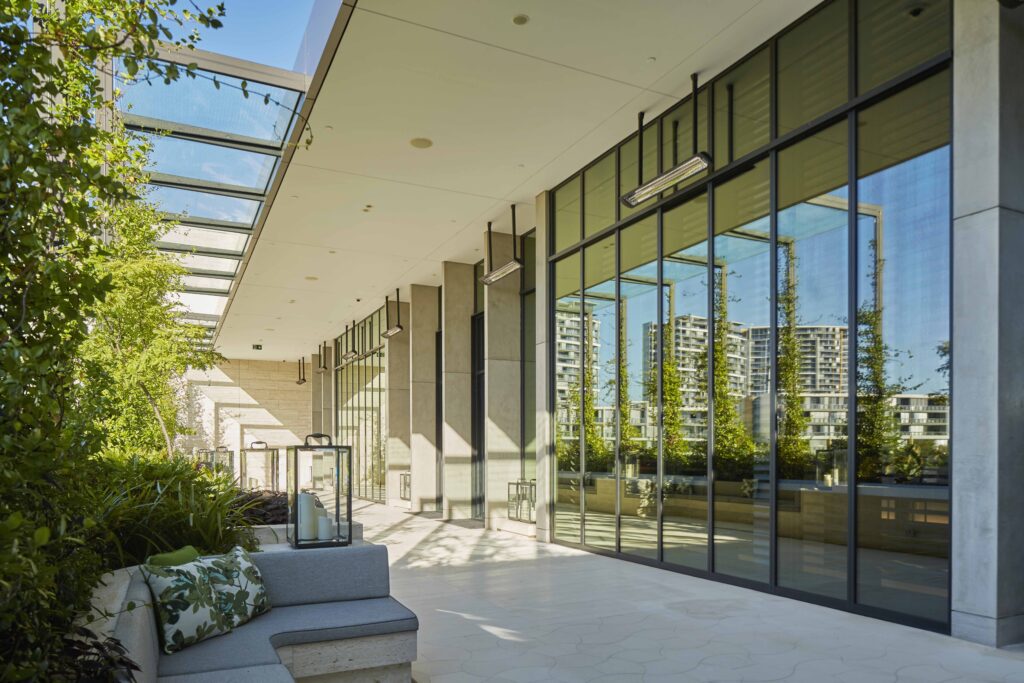Property owners increasingly find the design of their office as key to attracting & retaining tenants by creating inviting workplaces for companies and their employees. To successfully differentiate, owners are embracing Class A office outdoor amenities to attract companies and drive occupancy.
As the post-Pandemic world continues to evolve in terms of employee-employer relationships for remote work and return to office policies, office spaces will need to adapt to provide solutions appealing to both employees and employers to create the work place of the future. The first quarter of 2023 showed that 16 percent of office space was vacant in the United States, and vacancy remains high since the pandemic. As property owners are competing to bring employers and employees back to the office, competition has sparked a re-evaluation of traditional office spaces. Global real estate services company JLL found that organizations are opting for higher-quality buildings to address the vacancy gap, and at the same time, physical space design and amenities matter.
Architects and interior designers are providing solutions with creative approaches to offices, and one notable trend is the rise of outdoor office space amenities. These outdoor areas and features not only draw professionals back to the workplace, but also redefine how teams work together and office culture. As 90% of companies say they’ll return to the office by the end of 2024, teams are leveraging amenities to reimagine the in-office experience and elevate employee satisfaction.
The Rise of Outdoor Office Space as a Competitive Edge
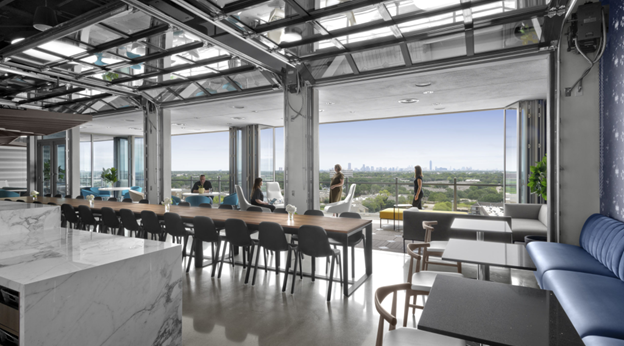
As businesses adapt to the changing dynamics of office spaces, the desire for more amenities has become a central theme. The acquisition of office spaces now extends beyond square footage considerations to include areas that allow for expanded offerings. Whether it’s spaces within an office for amenities that feel like home, or the integration of outdoor workspaces. “Highly sought-after amenities include concierge-style services, alternative workspaces like work pods and phone booths, outdoor space, and high-tech meeting spaces,” notes Rethinking Workspace in their 2022 study of office occupancy rates. In this, companies are recognizing the value of providing employees with the option to work in diverse environments and with open-air options. This shift marks a departure from traditional office setups, signaling a commitment to fostering a healthier and more balanced work-life integration.
In the competitive realm of modern business, offering outdoor office space amenities has become a strategic differentiator for property owners. It’s not merely about providing unique perks; it’s about improving the appeal of space for new commercial tenants so they can attract and retain top talent in an increasingly competitive job market. Outdoor amenities and work spaces give companies an edge in talent recruitment by providing diverse work environments that are engaging, inspiring, and conducive to collaboration. In turn, businesses that might be solely remote or have more traditional workplaces see the value of these spaces and are drawn to move-into offices with more modern business environments.
Property Owners must adapt to this shift by creating workplaces that stand out against the backdrop of alternative options like remote work. To be attractive for commercial tenants, office spaces of the future will need to create inviting spaces for employees to collaborate and where they want to work. The advantages of outdoor office spaces, coupled with other enhanced amenities, position property owners as not just providers of workspaces but as creators of vibrant and fulfilling professional experiences.
Outdoor Office Space Enhances Culture
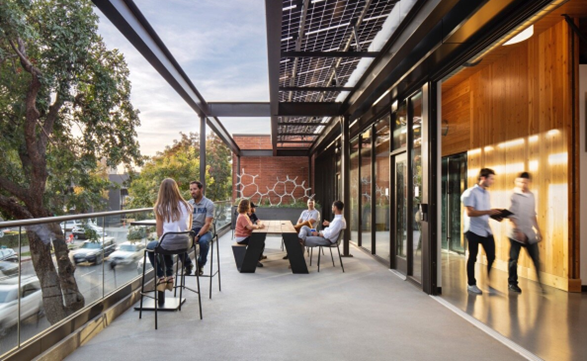
The integration of outdoor amenities into the workplace extends beyond pragmatic considerations; it significantly influences company culture and employee experience. Forward-thinking companies recognize that fostering a positive work culture is a key element in retaining and attracting talent.
One key to addressing this desire for a cultural shift in the workplace is through outdoor spaces and the amenities adjacent to an office. Workplace strategy expert Leigh Stringer conducted a survey for L.L. Bean of over 1,000 professionals aged 22-65 who worked primarily indoors. The survey revealed that nearly 90% of employees prefer to spend more time in the open air during the workday. This includes everything from rooftop gardens with outdoor heaters, to fountains and outdoor meeting rooms with shade structures to help ease the transition from home to the workplace. As global commercial real estate services firm Cushman & Wakefield found, there has been a 10% drop in workplace bonds and connections—crucial to personal well-being—over the past three years. Outdoor workspaces counteract this drop in workplace bonds and connections by creating a dynamic and collaborative atmosphere, enhancing employee well-being, and promoting a sense of community. As companies prioritize the well-being of their workforce, they also cultivate a positive brand image that resonates with both employees and clients.
These workplaces rethink the confines of traditional office design. As JLL’s research further illustrates, outdoor space is one of the top amenities tenants are searching for. These outdoor spaces become dynamic hubs where employees can collaborate, ideate, and build relationships in a relaxed and open setting. Whether it’s a landscaped terrace, a green rooftop oasis, or a well-designed courtyard, outdoor areas offer a breath of fresh air, quite literally, to the corporate culture. The informality of these settings encourages spontaneous interactions and team bonding such as social happy hours, contributing to a more vibrant and cohesive workplace culture. As outdoor spaces become synonymous with positive experiences, they play a crucial role in defining a company’s identity and the culture it cultivates.
There are a number of approaches companies can consider for outdoor office spaces that work within their culture and layout:
- Rooftop Terraces: Rooftop terraces provide a unique and elevated perspective for employees, offering a refreshing break from traditional office settings. The open-air environment promotes relaxation, creativity, and casual collaboration. This outdoor space can be utilized for team meetings, social events, or individual work, fostering a dynamic and versatile workspace.
- Landscaped Courtyards: Courtyards offer a serene and green escape within the office premises. Landscaped with plants, seating areas, and possibly water features, these spaces provide a tranquil setting for employees to unwind and recharge. They enhance well-being and reduce stress, as well as contribute to a positive company culture by encouraging informal interactions.
- Outdoor Meeting Areas: By creating meeting areas outdoors, these can bring a breath of fresh air to conventional corporate discussions. Whether equipped with comfortable seating, shade structures, heaters, or even outdoor technology, these spaces offer a change of scenery for more dynamic and engaging meetings. Alfresco meetings can boost creativity, enhance communication, and contribute to a more relaxed yet focused work atmosphere.

- Dining Options: These include restaurants with outdoor dining options that are either adjacent to an office space or housed within a larger office building or complex altogether. Wakefield Research found that creating dining options has a major impact on productivity, well-being, and loyalty. In turn, nearly 1 in 3 people surveyed said meal benefits would entice them to go into the office more often. Diverse dining options become a differentiator in the competition to retain tenants and attract new ones.
- Flexible Garden Workspaces: Incorporating flexible garden workspaces allows employees to bring their tasks outdoors. These areas can feature Wi-Fi connectivity, power outlets, and comfortable seating arrangements, providing a blend of nature and productivity. This type of outdoor workspace supports individual focus, accommodates varied work preferences, and aligns with the modern understanding of work-life integration.
- Outdoor Activity Spaces: Companies not only need the right mix of outdoor office areas, but also those that accommodate a range of activities. A recent report by the workplace strategy and design firm Unispace shows that activity spaces are conducive to a more creative and productive work environment. From social spaces with outdoor games such as ping pong, mega-jenga and cornhole, to yoga spaces and outdoor fitness areas, companies are realizing that employees want areas to collectively take a break and recharge.
Incorporating these outdoor workspaces into office design not only provides employees with a variety of settings to choose from but also promotes a holistic and innovative approach to work. These environments contribute to a healthier work-life balance, stimulate creativity, and enhance overall job satisfaction, making them integral to the evolving landscape of modern office design.
In the competitive landscape of business, a distinct brand image is a valuable asset, and outdoor amenities serve as a powerful tool in crafting this identity. The deliberate choice to invest in outdoor workspaces communicates a commitment to employee well-being, innovation, and a progressive work environment. The visual appeal of lush greenery, open spaces, and thoughtfully designed outdoor areas creates a positive impression. This intentional approach to workspace design positions the company as forward-thinking and in tune with contemporary workplace trends, making it an attractive alternative to traditional workspaces. Moreover, the incorporation of outdoor amenities can align with broader societal values, showcasing corporate responsibility and environmental consciousness, thereby contributing to a brand image that transcends the conventional boundaries of business and resonates with a broader audience.
Bringing Business Back
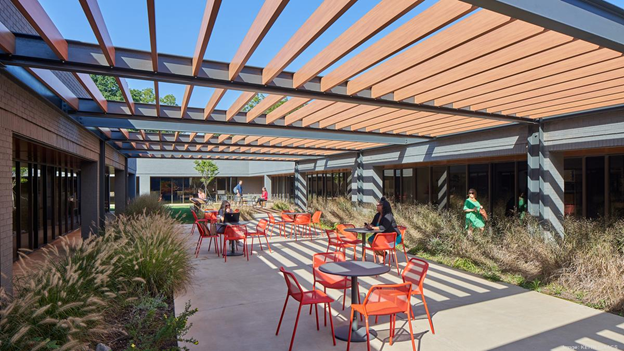
Outdoor work areas not only bring professionals back to the office but are also transforming the dynamics of office space competition. This landscape has undergone a paradigm shift. The demand for flexible workspaces has become a driving force, with property owners recognizing the importance of adaptability to attract and retain tenants. Class A office spaces are no longer solely defined by sleek interiors and high-tech facilities; they now need to meet the evolving expectations of companies and their workforces seeking a blend of comfort, flexibility, and innovation. This shift underscores the significance of creating work environments that cater to the diverse needs of modern employees.
In the drive to rethink Class A office space amidst heated competition, the strategic inclusion of amenities, including outdoor office space amenities, has emerged as a game-changer. As property owners invest in creating dynamic, flexible, and inspiring work environments, they not only drive occupancy but also help redefine the modern workplace. The shift towards outdoor amenities reflects a profound understanding of the importance of employee satisfaction, talent retention, and brand image in the current professional landscape. As property owners and businesses continue to adapt, innovative office space design and outdoor work areas stand out. Outdoor workspaces underline a commitment to creating offices that are inspiring, engaging, and that lead the way in the new era of work.

